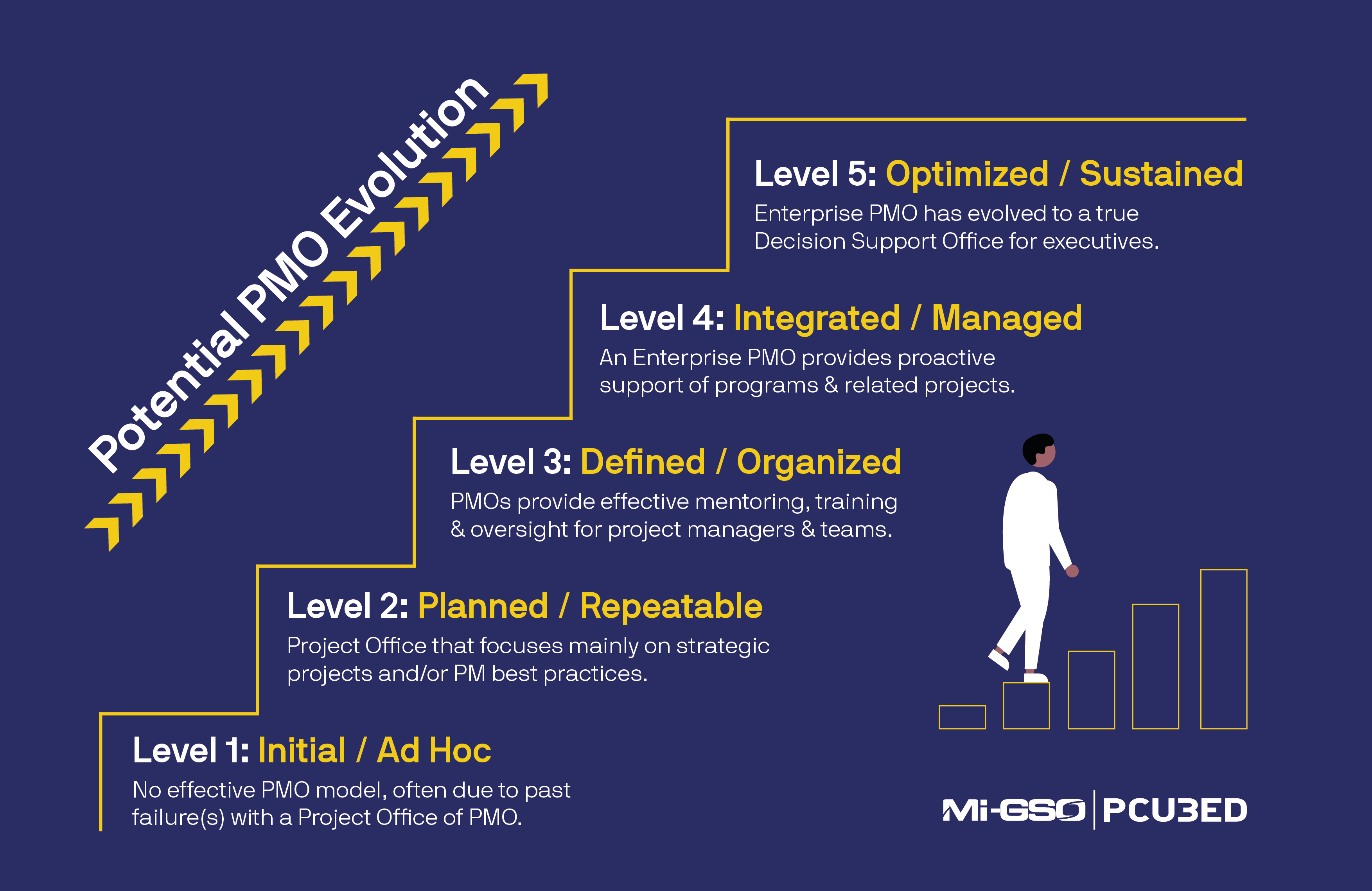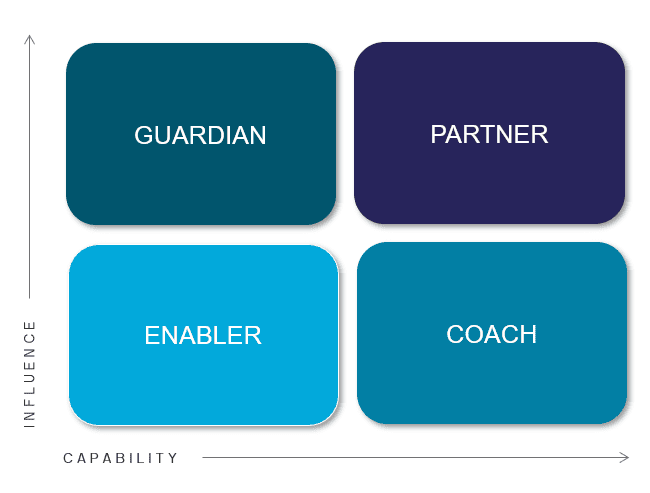Our website is not supported on this browser
The browser you are using (Internet Explorer) cannot display our content.
Please come back on a more recent browser to have the best experience possible

The PMO – the project, program, or portfolio management office – often gets a bad rap. When you say “PMO”, some senior executives may think of the good, but most shudder with the thought of administrative overhead moving paper around and policing to ensure compliance. Not your PMO, you say? That’s probably because your team focused on a PMO Improvement initiative. Not there yet? That’s okay, here we will walk you through how to get your PMO ready for what’s next.
The bad rap of the PMO hit its peak several years ago. So much so, our original piece on increasing PMO maturity was titled “Is the PMO Dying?”. Some of this was fear talking, with the rise of artificial intelligence (AI), but most of the conversation was valid and necessary. In 2017, a little over 70% of organizations had PMOs. However, the vast majority of them were unable to quantify their value – a term referred to as “Zombie PMOs”.
There was a time when simply managing project schedules and compliance documentation was all that was needed to ensure that the PMO was delivering value. Yet, that’s no longer the case. With all the work going on – innovation, rapid product releases, lean process improvement – the PMO is the glue that keeps it all together.
As such, PMOs need to adopt a more strategic mindset, looking beyond managing just the tactical aspects of project execution and linking their projects to the corporate strategy. Unfortunately, as surveyed by PMI in 2018, “only 41% of organizations with an enterprise PMO in place, feel that it is adequately aligned to strategy.”
So while the PMO is not dead, it does need to transform.
Looking first to set up your PMO? Read our PMO Setup and PMO Best Practices articles to get started.

There are many maturity models for PM Improvement – CMMI, P3M3, OPM3. In our article on Improving Delivery Capability with P3M3 and a recent case study on In-Flight Controls, we take you through our approach to PM Improvement. The case of moving your PMO up the maturity ladder really is no different. We just added a fourth step focused on continual evolution.
So your first question likely is “What is the PMO Maturity Model and where exactly are we on it?”
When a PMO isn’t doing the work expected, it’ll need to improve or evolve until they have the capabilities to do the job required. If they don’t, then the PMO may simply need to be eliminated. This is because it’s either viewed as an easy area to cut during a recession, or because the organization could benefit through other means.
This first step involves bench-marking the delivery of services from the PMO against an external set of standards. Organizations usually hire an outside advisor for an objective assessment of their PMO maturity. However, you can do an assessment internally; just make sure to not put too a rosy tint on your PMO activities.
The levels of PMO maturity are very similar to the levels of Project Management maturity, highlighted in the graphic below. Maturity goes from Level 1 (Initial / Adhoc), where there really is no formal PMO in place, all the way up to Level 5 (Optimize / Sustain).

So while discovering where your PMO ranks can be disheartening (especially if you rate yourself below a 1), the key here is to be honest. The only way to find out if your PMO actually provides value is to ask your stakeholders.
The good news is that while having these conversations, you’ll start to understand where you really need to be – which is step 2.
An interesting side note – project management offices are like people: they mature at different rates. As such, their maturity levels aren’t often where they need to be. However, unlike with people, some PMOs may not need to mature.
Often, PMOs fail because there is a mismatch in expectations or understanding of what their role is. As there is no single definition for a PMO, mismatches happen all the time. Furthermore, the lack of a clear purpose contributes to the uncertainty over the types and level of skill required by the PMO – leading to further issues.
Mismatched Expectations
Poor Execution
No Sponsorship
Seen as Overhead
Unclear Purpose
Cannot Articulate Value
Reasons PMOs Fail
For instance, it may be that the organization only needs a PMO at a given level. The key here is to establish a clear expectation on the role of the PMO, and then staff accordingly. This second step requires examining business requirements, including the pipeline of future initiatives and evaluating to see what other PMOs are doing well. By doing this, you can identify both where you need to move and why.
For example, say an organization was working on a critical transformation program with a large number of workstreams, each with their own project managers. The PMO’s directive was to ensure that all projects were on schedule. Therefore, the PMO focused on delivering accurate status reports to senior management.
In this specific situation, a compliance or guardian type of PMO was exactly what was needed. For more information, please see the 4 different roles played by PMOs section below.

In working with many organizations over the years, we have seen PMOs typically take on one of four different personalities.
The Enabler PMO, at the base of the maturity ladder, acts in a mostly administrative role. Think of this type of PMO as your one stop shop for all things methodology and data, gathering and publishing progress reports as an information hub. When a project manager wants to know which deliverables support a specific gateway or how to complete a task, the Enabler PMO can point to key process documentation to guide the project managers on what is expected.
A few rungs up the ladder in influence is the Guardian PMO. Frequently characterized as the police officer, this type of PMO ensures that project managers comply with the rules for running projects.
This type of PMO is typically staffed with people who are more experienced – both in the client organization and in project management methodologies. As such, members of the Guardian PMO will not only gather project reports, but will also analyze them. Their value is in acting as an early warning system to management, and presenting solutions to get things back on track.
In the Coach PMO, similar to the Enabler PMO, people staffed within have greater levels of experience, adding more value to the projects they’re involved in. Instead of interacting solely with project managers, they will actively communicate in both directions, summarizing initiative status up to the big picture portfolio level.
The people who staff a coach-level PMO know their methodology back to front, whether PMI or PRINCE2-based, SSM, or even PROSCI. Their value is in transferring this knowledge to the organization, upskilling project managers and embedding best practices as the teams complete their work. They influence behavior often by modeling it.
Finally, the most mature PMOs act as partners. The Partner PMO is populated with senior people with the capability to both design and put in place key processes and the experience to influence strategy.
If a project runs into trouble, the Partner PMO may align themselves temporarily to get the project back on track. The Partner PMO may also act as a delivery accelerator, restructuring existing business processes to better meet the needs of the organization or upskilling project managers.
With a more accurate understanding of the type of PMO you wish to be, you can determine the level of maturity that is right for your organization.
Now that you have established where you want to be, it’s time for Step 3 – summarizing key gaps identified during your stakeholders discussions and constructing a plan of action to fill them.
One typical approach to maturity improvement is to make a dedicated effort to build up the skills of internal staff. The challenge with this approach is that it’ll take some time to see any return on investment, as jumps in maturity can take upwards of 12 to 18 months.

If you don’t have that kind of time, a second approach is to outsource key skills or the entire PMO operation. We think of PMO managed services or PMO as a Service (PMOaaS) as the model for the future. The advantage of this approach is that you don’t need to manage multiple separate contracts or to hassle with getting independent contractors to operate as a team. And if things don’t go right, there’s a single point of accountability in order to target a fix.
However, if you are here, you’re probably looking for some quick wins for your own PMO. Unfortunately, we have to confess – there is no one-size-fits-all approach to PMOs. You have to do the hard work of understanding the gaps in expectations for delivery and defining improvement actions to rectify. Luckily, you don’t have to do it alone.
The key point is to decide on small steps of change, assess whether that delivers value, and then start again. This is our last step in moving our PMO up the maturity ladder.
Continuous improvement is the name of this game here. So you have to constantly be asking, “Is this where the PMO needs to be? Is there anything else we can offer? What else could we be doing?”
One way we have found to do that is to get influential stakeholders and project managers on your side. Tap into their expertise for managing projects and get their input for new ideas. Then, take bits and pieces of what they do, mesh them with the PMO’s best practices, and recognize their contribution to the project management office (PMO) maturation plan.
Additionally, the plan should set out communications for continuously managing client and stakeholder expectations. You need their buy-in, and you need to bring them along in the process. Otherwise, they’ll be highly suspicious when that Guardian PMO that was used to hitting project managers with “pointy sticks” suddenly starts dangling carrots and suggests teaching them something new instead.
When all is going well on projects, it’s probably because the PMO is doing its job, though it’ll rarely get the credit. Success is generally attributed to the project team – and that’s a good thing. However, think of talking about the value you provide, and a focus on continuous improvement as a bit of self-preservation. If people don’t know what you are working on and how you can help them, you won’t be able to help them.
So, no matter what level your PMO currently works at, make sure you have a strong team who can each communicate what the PMO is doing and how it delivers greater value for the business. Be prepared to shine a spotlight on the PMO. All it may take is a little maturing.
You might also like:
Loved what you just read?
Let's stay in touch.
No spam, only great things to read in our newsletter.
We combine our expertise with a fine knowledge of the industry to deliver high-value project management services.
MIGSO-PCUBED is part of the ALTEN group.
Find us around the world
Australia – Canada – France – Germany – Italy – Mexico – The Netherlands – Portugal – Romania – South East Asia – Spain – Switzerland – United Kingdom – United States
© 2024 MIGSO-PCUBED. All rights reserved | Legal information | Privacy Policy | Cookie Settings | Intranet
Perfect jobs also result from great environments : the team, its culture and energy.
So tell us more about you : who you are, your project, your ambitions,
and let’s find your next step together.
Dear candidates, please note that you will only be contacted via email from the following domain: migso-pcubed.com. Please remain vigilant and ensure that you interact exclusively with our official websites. The MIGSO-PCUBED Team
Choose your language
Our website is not supported on this browser
The browser you are using (Internet Explorer) cannot display our content.
Please come back on a more recent browser to have the best experience possible
